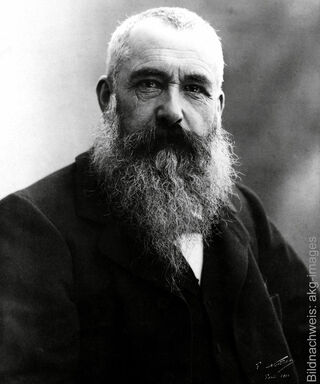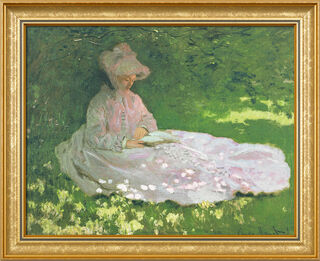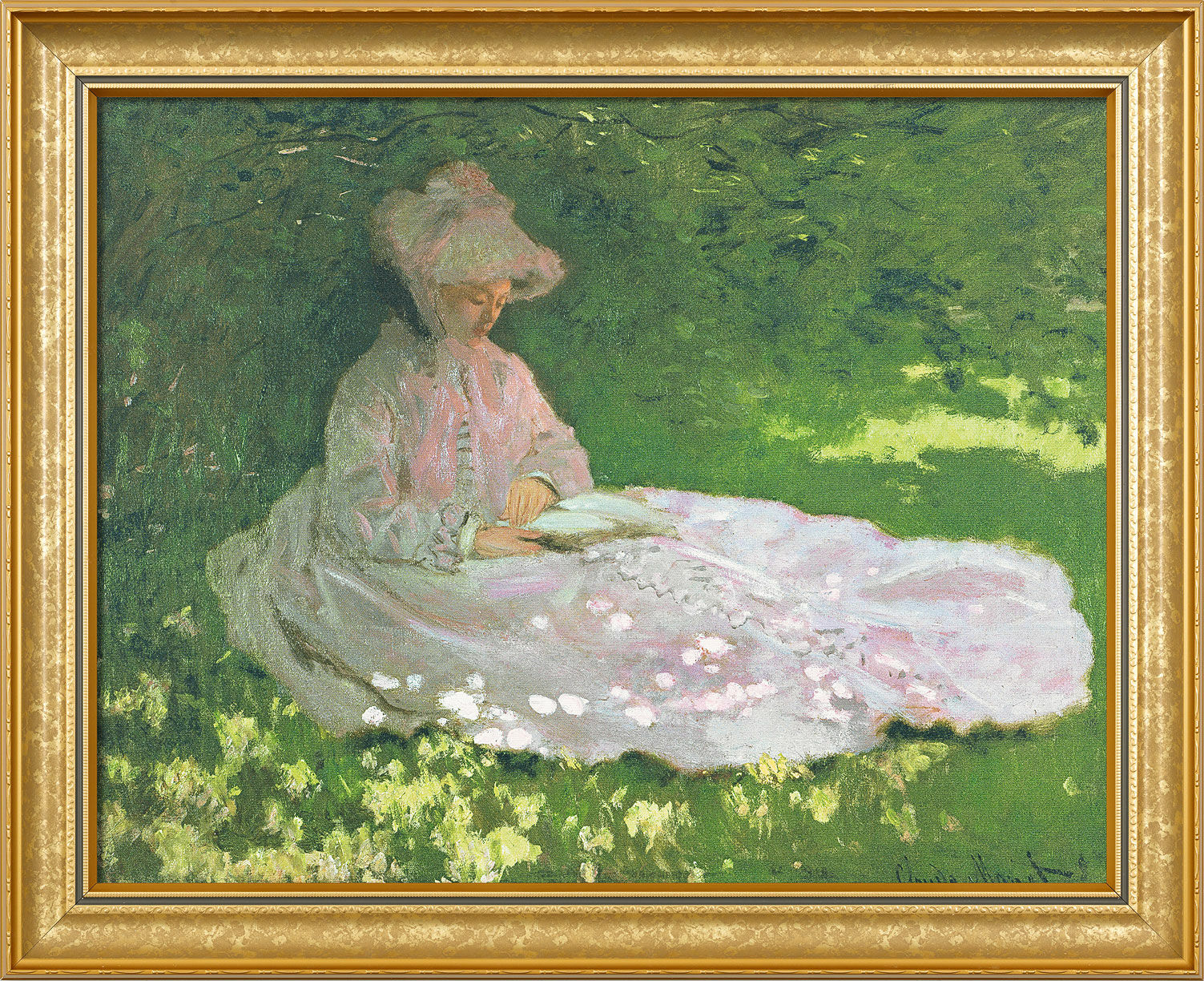Picture "The Reader" (1872), framed


Picture "The Reader" (1872), framed
Quick info
ars mundi Exclusive Edition | limited, 499 copies | reproduction, Giclée print on canvas | on stretcher frame | framed | size 65.4 x 80.4 cm (h/w)
Detailed description
Picture "The Reader" (1872), framed
Monet produced this impression of a reader as one of the first pictures in the garden of his new house in Argenteuil. Original: 1872, Walters Art Gallery, Baltimore.
Brilliantly coloured Fine Art Giclée print on artist's canvas and mounted on a wooden stretcher frame like an original oil painting. Framed in an elegant frame. Limited edition of 499 copies. Size 65,4 x 80,4 cm (h/w). Exclusively at ars mundi.
Producer: ars mundi Edition Max Büchner GmbH, Bödekerstraße 13, 30161 Hanover, Germany Email: info@arsmundi.de
Customer reviews
Sehr zu Frieden!!
Werde wider beim arsmundi, wider bestelle.. Sehr freundlichen Mitarbeiter!!
Ich habe dieses Bild ganz bewusst aus unzähligen anderen Bildern ausgesucht. Das Motiv ist traumhaft schön und das Bild sowie der Rahmen gefallen mir sehr gut. Es hat seinen Platz über einer Jugendstil-Kommode von meiner Urgroßmutter - wunderschön.

About Claude Monet
1840-1926
The art of Claude Monet is the epitome of Impressionism. During his long life as a painter, he was tirelessly searching for new ways to depict the variability of light and colour in many various atmospheric variations and at different times of the day.
Monet was born in Paris, but grew up in Le Havre, on the Normandy coast, where his father ran a small grocery shop. He made his early artistic attempts with caricatures but then switched to open-air painting. Light pastel tones found their way onto his canvases. His paintings were repeatedly rejected by the official Paris Salon, but Monet and his friends Auguste Renoir and Alfred Sisley were not discouraged. On their joint excursions to Fontainebleau, they created magnificent fresh paintings in the open air that left the strict academic rules further and further behind.
However, severe financial crises hit Monet and his pregnant beloved Camille. During the Franco-Prussian War, Monet fled to London with his young family. After the war, they settled in Argenteuil. This small town outside Paris, picturesquely situated along the Seine, became the centre of attraction for a whole series of Impressionist painters: Edouard Manet, Gustave Caillebotte, Camille Pissarro, Auguste Renoir and Alfred Sisley met there to capture their impressions on canvas. In the group's first independent exhibition, a painting by Monet entitled "Impression. Sunrise" gave the art movement its name.
After Camille's death, Monet moved to Giverny with his second wife Alice. Here he was able to realise his lifelong dream of having his own garden, designed by himself: The flowering garden with its Japanese bridges and ponds full of water lilies inspired Monet constantly to create new, ever larger paintings showing the changing plant life as an overwhelming decorative harmony of nature.
This estate, which was bequeathed by Monet's son to the Academié des Beaux-Art in 1966 and is open to the public through the "Claude Monet Foundation" since 1980, was an inexhaustible source of inspiration for him. Today, the garden in Giverny is a destination valued many art lovers. Anyone who visits it feels immediately transported into the artist's pictorial world. In spring, colourful blossoms are all over the place, and while looking at the real water lily ponds that Monet painted over and over again, visitors are amazed at how precisely he captured the scenery, despite all his artistic idiosyncrasies. "On my garden I work continuously and with love, most of all I need flowers, always, always. My heart is always in Giverny. A separation from Giverny would hit me hard ... never again would I find such a beautiful place." And he never had to separate with his garden; Monet died in his beloved Giverny on 5 December 1926.
Monet has been called the inventor of colourful dreams beyond the visible. But he was much more, always seeking to realise his idea of painting in the open air - en plein air. For his painting, the decisive factor was always how he sees, not what he sees.
Graphic or sculpture edition that was initiated by ars mundi and is available only at ars mundi or at distribution partners licensed by ars mundi.
Giclée = derived from the French verb gicler "to squirt, to spray".
The Giclée method is a digital printing process. It is a high-resolution, large-format print produced with an inkjet printer using special different-coloured dye- or pigment-based inks (usually six to twelve). The inks are lightfast, meaning they are resistant to harmful UV light. They provide a high level of nuance, contrast, and saturation.
The Giclée process is suitable for art canvases, handmade paper and watercolour paper as well as silk.
The style of Impressionism, which emerged in French painting around 1870, owes its name to Claude Monet's landscape 'Impression, Soleil Levant'. After initial rejection, it began a veritable triumphal procession.
Painters such as Claude Monet, Edgar Degas, Edouard Manet, Auguste Renoir and others created motifs from everyday life, urban and landscape scenes in bright, natural light.
Impressionism can be seen as a reaction to academic painting. Rather than emphasizing content with a structured composition, it focused on the subject as it appears in the moment, often in a seemingly random snapshot. The reality was seen in all its variety of colours in natural lighting. Outdoor painting replaced studio painting.
Through the brightening of the palette and the dissolution of firm contours, a new approach to colour emerged. In many cases, the colours were no longer mixed on the palette but placed side by side on the canvas, so that the final impression emerged in the eye of the viewer with a certain distance. In "Pointillism", (with painters such as Georges Seurat or Paul Signac), this principle was taken to the extreme.
Outside France, Impressionism was taken up by painters such as Max Slevogt, Max Liebermann and Lovis Corinth in Germany, and by James A. M. Whistler in the United States.
However, Impressionism was only expressed to a limited extent in the art of sculpture. In the works of Auguste Rodin, who is considered one of the main representatives, a dissolution of surfaces is evident, in which the play of light and shadow is included in the artistic expression. Degas and Renoir created sculptures as well.


